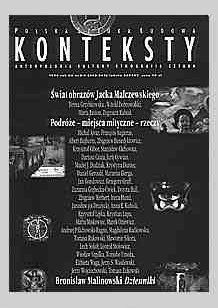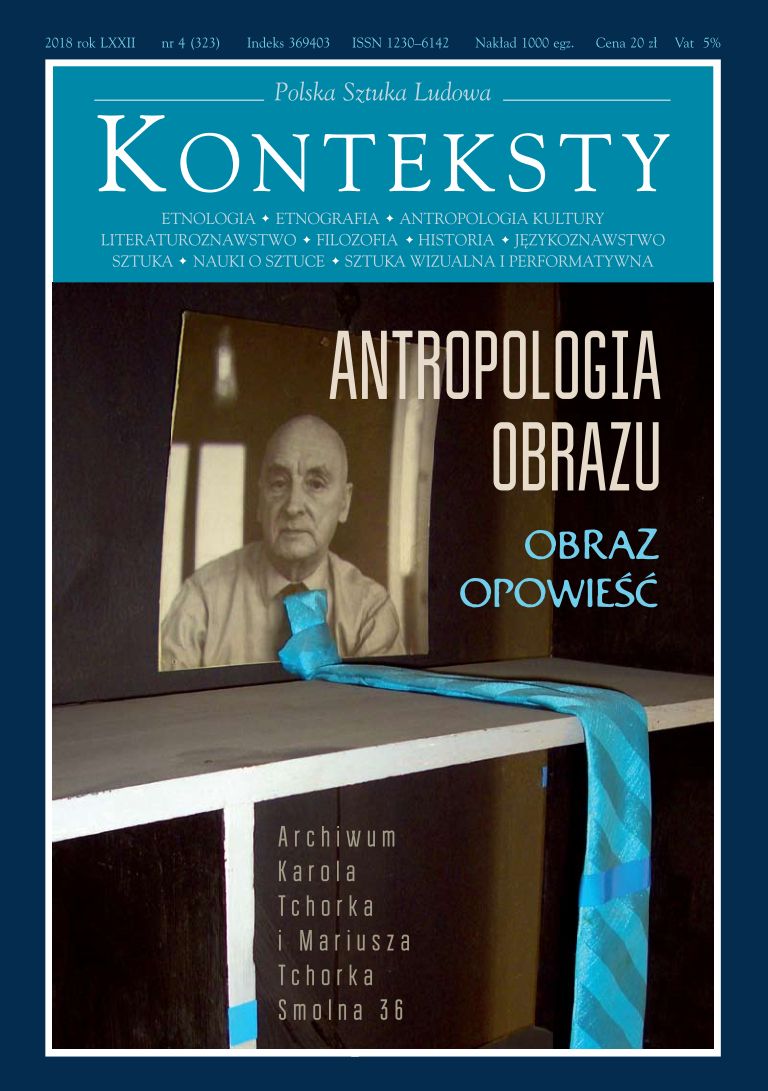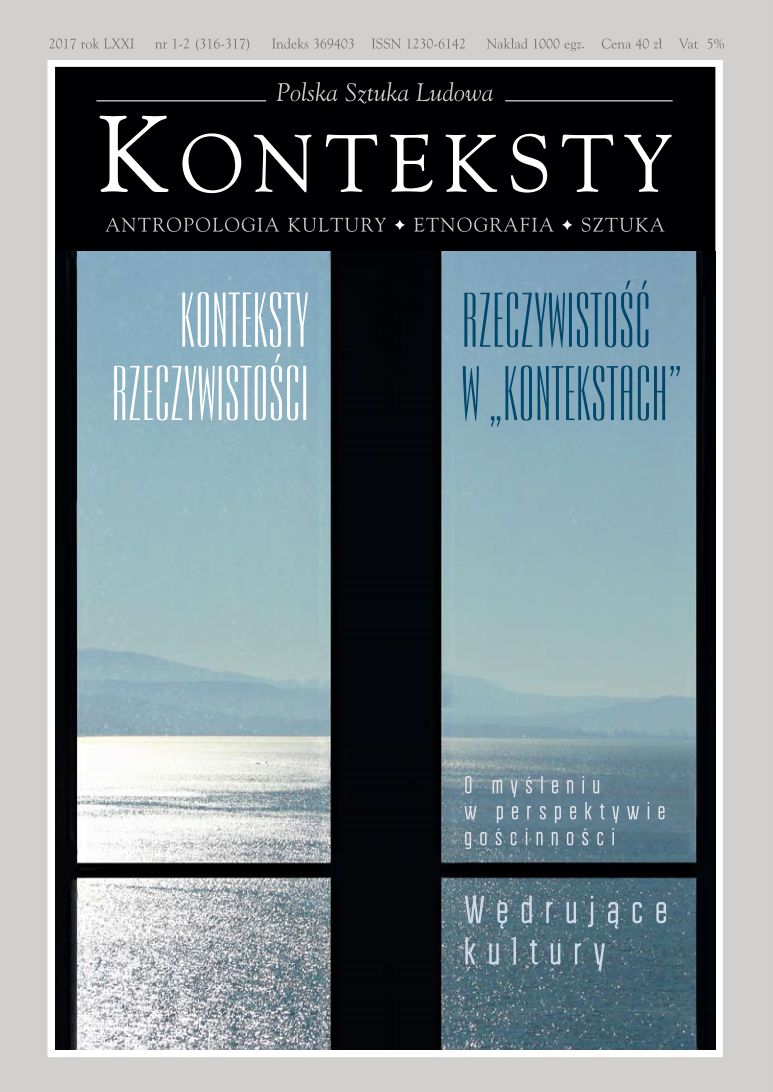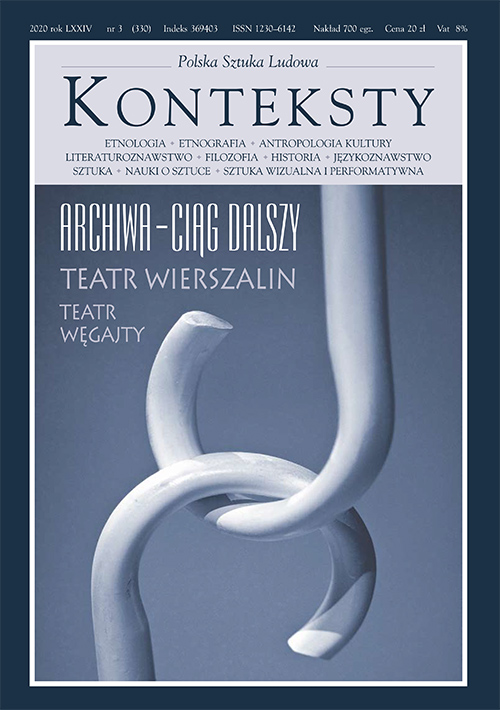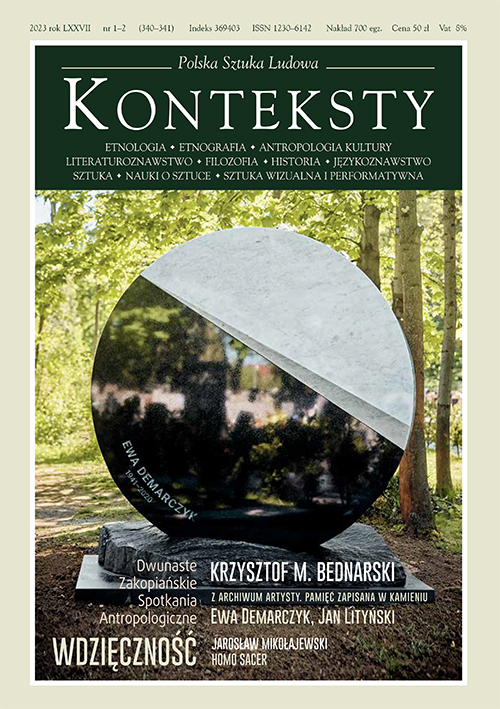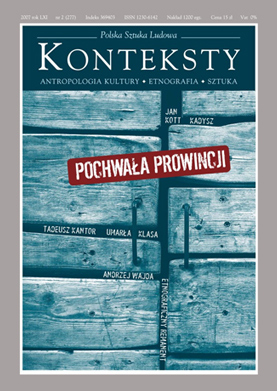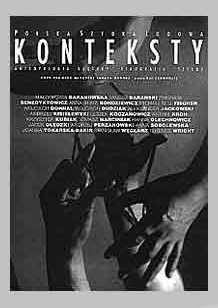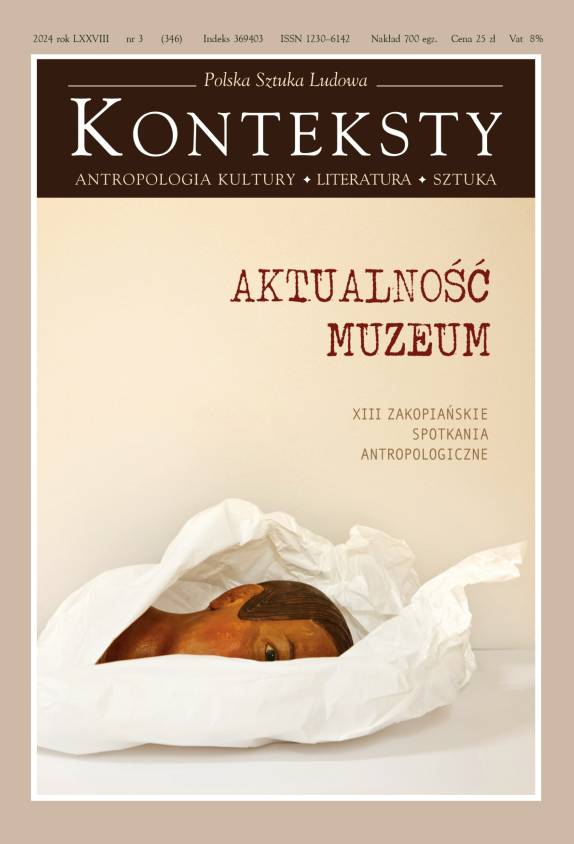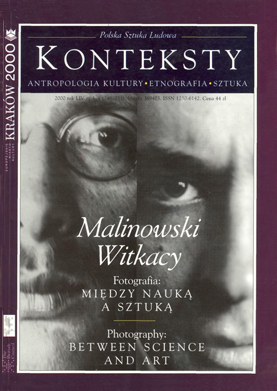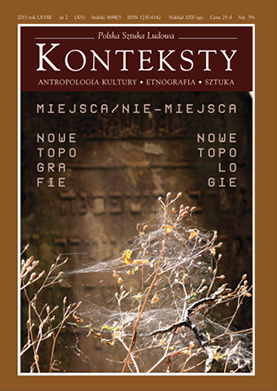Issue 2012/3-4 (298-299) - Konteksty

| *** | ||
| Tomasz Szerszeń, Dariusz Czaja | The Ball as the World  | 4 |
The Anthropology of Football The text envisaged as a sui generis introduction to this issue begins with a phrase from Antoni Słonimski’s poem: Kontrmarsz, written in 1923 in response to Vladimir Mayakovski’s Left march! (1919) and in contrast to the incorrect perception of football as a synonym of primitiveness, indicating the intellectual dimension of the game and its force as a cultural phenomenon deserving the closer attention of the anthropologist of culture. In reference to texts amassed in the issue (by such authors as Stomma, Bredekamp, Czaja, Szerszeń et al.) and the complex image of football encountered in Heinrich Böll’s The Clown emphasis has been placed on its almost religious (quasi-religious) character, demonstrating the startling conquest of the world by football as well as the presence of “thinking in football categories” in contemporary language, politics and culture. Present-day football is not only the Great World. It is Galactic and Global, a supra-national and international oecumenic community, a world with a language of its own. While characterising football – that ”beutiful game” – as “volatile thought” the author described it as a “dynamic community of thought and comprehension”. In a discussion of the documentaries: Pelada (USA, 2011), Blind Ambition (UK, 2010) and My Mate Manchester United (Bulgaria, 2011) shown as part of a film review accompanying the festival of football culture in Warsaw at the time of the latest European Football Championship (Euro 2012) the author justified football as a Space of the Imagination, Freedom, Dialogue and Meeting. | ||
| Zbigniew Benedyktowicz | 6 | |
| Kazimierz Wierzyński | 18 | |
| *** | ||
| Horst Bredekamp | Foot, Fortune, Ball: the Platonic Principles of the Handicap. The Globe and Deficits of Completeness  | 19 |
The text deals with the historical and mythical sources of football. The author analysed the globe-ball-cosmos motif, concentrating on Plato’s myth of creation and spectacles at the Florentine court of the Medicis. | ||
| Tadeusz Konwicki, Gustaw Holoubek, Stanisław Dygat | Sorry about the Disturbances  | 25 |
Record of conversations held by three outstanding Polish artists at the time of the 1974 World Cup. | ||
| Przemysław Kaniecki | “Less for medals”. Dygat, Konwicki and Holoubek as 1974 World Cup Commentators in “Literature”  | 39 |
A series of talks between three famous friends and artists (two writers and an actor) was entitled We apologize for the drawbacks and was published in an important Polish art magazine “Literature”. The talks were extremely popular at the time – it was a very special period for Polish football. The talks can be approached in many ways, i.e. as a commentary on the World Cup, as a reflection on sport and it’s transformations, as a document of intellectual formation and a kind of a portrait of certain characters. Kaniecki focuses on observations of these three commentators about the so-called national character. | ||
| Stanisław Barańczak | Neeskens Will Not Spit in Our Face  | 44 |
Football and the Polish question – this critical feuilleton is about the comic strip: Od Walii do Brazylii (From Wales to Brasil), presenting the triumphs of the Polish team. | ||
| Jurij Andruchowycz | Game of Chance  | 45 |
This literary essay has a strong biographical foundation. The author followed the history of football in Ukraine (to the 1990s a part of the Soviet Union) and devoted particular attention to the Dynamo Kiev football club. He also sketched a credible portrait of the celebrated Ukrainian player (and coach) Valeri Lobanovsky. | ||
| Marek Bieńczyk | Football as the Space of Dreams  | 55 |
A record of an imaginary correspondence between the football fan and debuting man of letters Jan Jo Rabenda and leading Polish Czechophile publishers, concerning the mysterious and forgotten book by Eduard Bass: Klapzuba’s Eleven. | ||
| Krzysztof Mętrak | The Alchemy of the Zośka  | 61 |
In this feuilleton-reminiscence Krzysztof Mętrak – film and literary critic, passionate fan football fan – recalled zośka, a game popular during his childhood, simultaneously executing a mini-portrait of Warsaw immediately after the war. | ||
| Jerzy Górzański | Dependent or Independent Football? Snow  | 62 |
Two short forms (feuilleton and literary) by Jerzy Górzański: writer, resident of Warsaw, and football expert. | ||
| Jerzy Górzański | 63 | |
| Danilo Facca | Pallone, Calcio and Liedholm’s Cakes  | 64 |
An expansive – in reference to the author’s personal recollections – study on the transformations of Italian football. The text shows the enormous change of two forms: post-war Italian football (1945-1880) and an edition whose beginnings go back to the turn of the 1970s. The first form (pallone) was a sport strongly enrooted in plebeian festivities and folk competition, watched “live” on the stadiums. The second (calcio) is already a fully professional sport subjected to the laws of business and commercialised and, most importantly, followed to a great extent through the intermediary of television. Did the “modernisation” of football have to take place at the cost of annihilating Pallone culture and the desacralisation of Sunday, robbed of the afternoon ritual in order to fill the whole weekend and Monday with matches so that as many spectators as possible could watch them on pay television channels? | ||
| Kasper Bajon | The Sadness of Calcio  | 68 |
This short essay is about Italian football and how it grew with the culture and history of this amazing country. The author of this issue recounts his childhood days, when he was a great fan of AC Milan. He is summing up the beginnings of his fascination with calcio, and trying to answer the crucial question: “What happened to Italian football?”. | ||
| Simon Kuper | Of Bunkers and Cigars: The Holocaust and the Making of the Great Ajax  | 72 |
A colourful tale about the legendary Ajax Amsterdam football club in the 1960s and 1970s – its status was created by Holocaust survivors. | ||
| Iwona Kurz | Auschwitz Matches and Games. Football in KL Auschwitz-Birkenau  | 79 |
Modern sport is the child of the same epoch that gave rise to Auschwitz. Sport entered the international arena together with nineteenth-century national renascence and the idea of the national state. Up to this day, such events are the only peacetime occasion for a regular and open unification of nation-states (Dunning). The author of the Olympic idea – Baron Pierre de Coubertin – stressed two dimensions of sports: rivalry was to become the foundation of an international harmony of nations whose force is created by training. In the development of modern societies, sport, thanks to imposed discipline, was to harden the spirit and, at the same time, develop the body of the individual, the foundation of a healthy social organism. In turn, “concentration camp” can be understood as an institution that focuses and radicalises, and brings to a visible extreme the assorted dimensions of the “normal” world of modernity, often transparent on a daily basis (Bauman, Agamben). The term “sport” functioned in the reality of Auschwitz in a double meaning. First, it denoted sports events held on a semi-legal basis, and secondly – it involved tormenting the inmates by forcing them to perform exhaustive physical exercises. The article shows the consequences of the presence of sport in concentration camp reality, and devotes most attention to boxing and football events, in particular in KL Auschwitz-Birkenau, where the football field, described by i.a. Tadeusz Borowski, was situated right next to the Judenrampe, where people condemned to death in the gas chambers got off the arriving trains. | ||
| *** | ||
| Dariusz Czaja | Game of Metaphors. Writers about Football  | 85 |
Why is football such a popular sport? What does the force of its hypnotic attraction consist of? What is decisive for its universal range? What language best reflects the essence of football? The author seeks answers to these questions in texts by assorted writers, who found football exciting (and in certain cases actively pursued it). The analytical but deeply emotional statements made by outstanding men of letters (A. Kijowski, J. Pilch, S. Rushdie, R. Coover, B. Hrabal) contain numerous metaphorical expressions intent on describing football. The interpretations and assessments pertain to football as a spectacle, a Mass, a holiday, a (existential) sacrament and a circus. | ||
| Dariusz Kosiński | An Evening in the Theatre of Dreams. Comments on the NonTheatrical Nature of Football  | 93 |
While treating the football match and football as such as a specific and multi-dimensional phenomenon that, at the same, time, possesses numerous features analogous to better examined and described cultural phenomena, the author proposes to apply select theatrical conceits for the purpose of analysis. In doing so, he does not intend to prove that football is a theatre but through an analysis of those theatrical elements he hopes to capture certain traits specific for the football spectacle. The text considers successively an analysis of: 1) the manner of building, and the functioning of, characters created by football players (with Leo Messi and Cristiano Ronaldo as examples); 2) the relations between the fictitious and real nature of the football match; 3) the sui generis “scenario” of matches in the perspective of their foreseeability and non-predictability. Such analyses are to prove a thesis maintaining that the cultural and political significance of football is to a great extent the outcome of the fact that it is probably the purest model of fiction endowed with enormous real effectiveness, acting as a spectacular meta-commentary on contemporary Western culture. | ||
| Mateusz Kanabrodzki | Echoing Vuvuzelas  | 101 |
The author returns to the World Cup organised in the capital of South Africa in 2010. In a contribution to the psychoanalytical theory of football, he focuses his attention on the custom of blowing plastic trumpets (vuvuzelas) on South African stadiums; subsequently, this practice became disseminated across the world. The text cites assorted genological hypotheses without resolving their veracity. One of them goes back to the Hebrew Rosh Hashanah and the instrument played in its course – the shofar. By citing a new interpretation of the shofar formulated by Theodor Reik, which owes much to the story about the beginnings of culture recounted by Freud in Totem and Taboo, the author attempts to discover the concealed traces of psychic reality in a football match. | ||
| Zbigniew Pasek | What Sort of Salvation Does Cracovia Offer?  | 104 |
The article deals with the spirituality of sport, with the author embarking upon the fulfilment of religious functions by extra-religious domains of culture. He discusses this question upon the example of football and the Cracovia club from Cracow. The titular “salvation” refers to Oriental soteriological conceptions that regard the goal of human life to be inner development and the attainment of “higher levels” of temporal life or the realisation of certain positive values. Sports fans can be perceived as quasi-religious groups involved in the realisation of community and transgression needs. According to the interpretations proposed by certain theories of religion, these are the fundamental features of religious life. | ||
| Piotr Jakub Fereński | Pearl in the Crown  | 115 |
The essay considers the possibility of connecting certain elements of religious life and the practices, customs, and traditions associated with football. The author analysed predominantly the example of the Real Madrid football club and its aficionados. | ||
| Ludwik Stomma | 1:0, or People Like Gods  | 121 |
Of the many ways of explaining the popularity of sport, the author proposes the ethnological interpretation which reaches to the mythological sources of the phenomenon. It is obvious that sport is a classification, a division into “we” and “they”. This classification, however, is not created by laws which function on a daily basis. Western sport teams are usually multi-national, while Polish ones, although a foreigner or two can appear, seem to be much more uniform – but how many true Warsaw residents play in the Legia team? The greatest importance is ascribed to the national colours which decide who is “ours” and who is not. Sport is ruled by laws analoguous to those of a carnival and football is the queen of all sport; it is here that a radical reversal takes place: hands, used everyday (cf. the number of idiomatic expressions connected with them) are replaced by feet. A football match is a reversal of the Promethean feat. The collective effort of the team creates a situation advantageous for one its members, who, with his legs, must conquer the only “normal” person – the goal-keeper, who relies on his hands, while the loot (the ball) is left on alien territory, the “other world”. The player who shoots a goal is, therefore, a anti-Prometheus, who returns fire to the gods. We are dealing here with a reconstruction of chaos (on a social scale, much smaller than the cosmic one) in order to repeat once again the act of creation. | ||
| *** | ||
| Roberto Da Matta | Futebol. Notes  | 125 |
In an environment as highly hierarchized as Brazilian society, space created by football opens up the possibility of unhampered and individualised expression; here, everyone can demonstrate his talents and weaknesses. Victory won thanks to aptness and own achievements is a “miracle” of sorts that has no chances of being repeated in ossified Brazilian society. It can appear only in a space open to individual expression: the widely comprehended space of the “game” in futebol but also the samba, the carnival, the umbanda, and art, where individuality rules. Futebol also expresses the tension between destiny, i.e. a collective and impersonal force, and individual desire that aims at breaking the social chain of poverty and at liberation from the feeling of defeat. The game of futebol – or rather: futebol as a game – remains thus in the very centre of powerful folk dramaturgy. | ||
| Maciej Rożalski | Torcidas  | 131 |
The text describes one of the matches played by local teams at the Pituaçu stadium in the Brazilian town of Salvador. By applying the reportage technique the author shows the world of Brazilian football and groups of fans, at the same time analysing the phenomenon of the latter’s organisation into associations. Brazilian football fans create so-called torcidas organisadas, which at first glance are similar to many such groups the world over. In reality, however, they are extremely well organised and ruled by certain codes and aesthetic; their stadium applause assumes the form of performance confrontations in which the winners are torcidas capable of showing the most attractive spectacle. | ||
| Magdalena Barbaruk | Football as a Cultural Machine? Narrations about Argentinian Identity  | 135 |
The point of departure for the presented reflections on the significance of football for the formation of Argentinian national identity is the book by Pablo Alabarces: Fútbol y Patria. El fútbol y las narrativas de la nación en la Argentina, an attempt at scientific examination with the assistance of categories borrowed from studies on culture, sociology and anthropology. The author argues that in certain countries football can be a crucial phenomenon enabling the examination of culture; more, today it appears to be a phenomenon that allows a description of global post-national television culture. The author claims that Alabarces’ book is not a work about football but a pioneering publication on cultural studies, for which football comprises “only” the object of cognition. | ||
| Magda Szcześniak | Rainbow Scarves, or In Four Years It Will Be Too Late  | 145 |
With an outline of the atmosphere of homophobia prevailing on European football stadiums as her point of departure, the author considers identity policies accessible to gay players and fans of non-normative sexual identities. A radical form of resistance against stadium homophobia was, i.a. an initiative (apparently fictitious) of Polish gay football fans, which they called Rainbow Stands. Members of this venture, created in reality by Paweł Demirski and Monika Strzępka as well as actors of the Polski Theatre in Wrocław supporting them, demanded space separated from other fans, i.e. the construction of special stands for fans identifying themselves with the LGBTQ movement. The author analysed this tactical proposal, developed by Demirski and Strzępka in the spectacle Tęczowa Trybuna 2012 (Rainbow Stand 2012), in the light of the anti-social queer theory represented by Lee Edelman. | ||
| Zbigniew Majchrowski | Football as Introduction to Gender Studies  | 153 |
The football team is a representation of the “masculine gender”. A characteristic element of contemporary football teams is their heterogeneity – in this case the “masculinity” is the common element. But this base is becoming unstable – if we take into consideration such issues as: the presence of woman's look on football, the meaning the image of football players joying after scoring a goal (if we displace it from the football context), or the presently occurring redefining of masculinity – along with the phenomenon of metrosexuality and the sexualisation and fetishisation of football players’ bodies. | ||
| Jo Harper | No More Heroes. Why Class Matters in the Demise of English Football  | 157 |
The essay takes an anecdotal journey into a boy’s experience of growing up in a polarising and revolting London in the 1970s, with the football terraces a public arena in which these changes were both reflected and driven. A personal lament as to why England is so bad at the game they invented. | ||
| Karolina Kosińska | What About a Match? Football According to Ken Loach  | 160 |
Ken Loach remains one of the most engagé directors whose films focus predominantly on contemporary British social issues; he is a declared socialist who consistently and decidedly supports those who had been relegated to the margin of society. At the same time, Loach is a passionate football fan – not by accident does he introduce into his films assorted football motifs. Football appears, however, not to be so much a form of entertainment or an exciting sport as an instrument of political struggle. Its importance lies in the fact that it builds a feeling of community. Loach tries to restore the original ethos of football and return it to the working class, which had been to a certain extent deprived of it due to the extreme commercialisation of the football business. The presented text recalls the director’s films in which football is markedly present and tries to decipher the sui generis political manifesto, which Loach inscribed into this sport. | ||
| Amelia Serraller Calvo | Spanish Reality from the Viewpoint of Football  | 165 |
The text discusses the multi-strata connections between Spanish football and the economic crisis, politics and history of the country. | ||
| Janusz Drzewucki | Globalisation, Football and Something More  | 171 |
A presentation of Franklin Foer’s book: How Soccer Explains the World: An Unlikely Theory of Globalization. | ||
| *** | ||
| Tomasz Szerszeń | Zidane’s Melancholies  | 175 |
One of the personages of sports, which has shone the brightest in the field of art, is the French football player Zinedine Zidane. This text presents two works, devoted to this player: the film Zidane: A 21st Century Portrait and the book La Mélancolie de Zidane. These two works present a “different” insight into football – close to the Freudian term “uncanny”. This term allows to look at football from the perspective of that, which is strange, disturbing, and even alien and impossible – what transcends the order of the match and knocks the spectator out of his routine. The culmination of this article is a look from that point of view, at the shocking blow delivered by Zidane during the World Cup finals in 2006. | ||
| Marc Artigau | Football Fiction  | 179 |
Mini-stories by the Catalonian playwright, read during “The Midnight Club” programme broadcast by Radio Catalunya. | ||
| Mateusz Kanabrodzki | Fragments of a Love Discourse about Football. The Beginning  | 181 |
This confession of love for football is modelled on A Lover’s Discourse: Fragments by Roland Barthes. The text was inspired by a wish to write about football in the same way in which the game is played. The point is not to write instead of playing, thus compensating “non-playing” but to play a game of writing. Listening closely to theoreticians of the discourse and discoursiveness who discover the body within the discourse, the author, upon the example of football, which he included into the active arts de faire distinguished by Michel de Certeau, tried to demonstrate the foundations of discoursiveness in football. | ||
| * | 187 | |
| * | 188 | |
| * | “A Frenzied Cry Can Be Heard at This Moment”. Wembley as a Text  | 189 |
One of the most famous matches played by the Polish national team took place 35 years ago – on 17 October 1973. The tie with Great Britain at Wembley Stadium guaranteed Poland participation in the World Cup finals in West Germany (1974) and a third place. This legendary match has been treated as a text, and we publish – word by word – the commentary by Jan Ciszewski accompanying the television broadcast. | ||
| Łukasz Sochacki | “Battle of England.” Wembley in the Press  | 205 |
A survey and an analysis of reactions in the Polish press after the “victorious tie” of the Polish football team at Wembley in 1973 in a match with the England favourites. Without doubt this particular meeting remains a myth, whose force fans appreciate up to this day… | ||
| Antoni Kroh, Barbara Magierowa | The Ball is Round or Square, or on Polish Football Vocabulary  | 219 |
Fragments of Prywatny leksykon współczesnej polszczyzny (The Private Lexicon of Contemporary Polish), on which the authors have been working already for several decades. This time, the entries refer to football, with the oldest dating back to the 1950s. | ||
| *** | ||
| Tomasz Szerszeń | Diego Maradona: Holy History  | 241 |
Diego Armando Maradona: no other football player had reached such a quasi-divine status as the one enjoyed today by this Argentinian player. No other has a “church” composed of more than 10 000 faithful followers. No player’s biography contains such drama or ambivalence. In none does football merge so closely with poetics and religion. Finally, no player has believed to such a degree in his divine calling, or that he is a incarnation of divinity whose site of revelation is the playing field. Interestingly, all biographies – books, films – apply a quasi-religious vocabulary to describe Maradona. At the same time, his life really does echo a model ascribed to certain saints or mythical figures. In no case is this, however, simple or exemplary “saintliness” but rather the model of a “holy sinner” or a holy fool at odds with the world… | ||
| Dariusz Czaja | The Lion and the Flea. The Magician from Rosario  | 249 |
A “Time” cover (February 2012) shows an almost life-size face of Leo Messi. The title of the lead article says in bold majuscule: KING LEO. Under it – a lead from Bobby Ghosh’s article: “Lionel Messi is the best player in the world and perhaps the best of all times”. The author tries to check the foundation of this hypothesis, seeking arguments in football statistics, opinions of assorted players, trainers and commentators. Finally, he stresses not only Messi’s excellent craftsmanship but compares his playing to art. In a justification of the thesis about the artistry and brilliance of the player from Rosario, he discovers parallels between the essential components of the mythical biographies of Messi and Mozart (wunderkind, slight built, the role of the father in the development of his talent, the puer aeternus syndrome). As Pep Guardiola declared: “The phenomenon of Messi cannot be explained and can be only admired”. | ||
| Kasper Bajon | To Describe Totti  | 254 |
Words are helpless when describing Totti. Historical analogies? Perhaps Robert Guiscard, Frederic Hohenstauff, Francesco Sforza, Gattamelata, possibly Cesare Borgia. In this manner Francesco “Il Capitano” Totti becomes part of a long list of heroic rascals from the Apennine Peninsula – cursed emperors, self-proclaimed princes, unruly condottieri. There is no, and probably has never been, player more immersed in world history. The captain of Roma is not a symbol of our times, and says nothing about our contemporaneity. Totti is not part of the present but resembles a hero from another distant epoch – a recollection of the might of the Italy of yore... | ||
| Marek Bieńczyk | The Face of Beenhakker  | 261 |
This sketch attempts a rendition of an existential portrait of the former coach of the Polish national team – Leo Beenhakker. Taking a close look at his face and subjecting its features to a profound analysis, the author transcends the range of an ordinary description and turns the examined countenance into an allegory of valour, manhood and invincibility, refined with the passage of years. | ||
| *** | ||
| Horst Bredekamp | Fertile Moment  | 264 |
An analysis maintained in the Warburg spirit: depictions of football and war share certain features, namely, they present people at a time of almost unsurpassable physical and psychic excitement. The tangle of opponents, who in synchronic tension give vent to their energy, conceals a certain affiliation of forms, to which the activity of memory refers also on the football field. Images of matches constitute an archive of this extreme experience. | ||
| Łukasz Zaremba | Flat Images of a Profound Game  | 272 |
The text is built around contemporary art works dealing with football and discusses select manners of viewing a match. In a reference to performance by Massimo Furlan entitled: Boniek! and a multi-media installation by Harun Farocki: Deep Play, the author does not contrast them as two basically separate types of experience – direct and via the media. The text attempts to show that both modes of reception incessantly mingle in practical observations of a sports spectacle. That which is mediated does not have to signify the absence of authenticity, experience or truth. Discussing the work by Harun Farocki the author refers to current debates concerning the inside of the world of football (supervision over the spectators, replays for the judges) but also poses a question about the information that can be absorbed. The Farocki’s installation – 12 monitors showing the finale of the 2006 World Cup from different perspectives – has been presented as a meta-image commenting on the conditions of the origin of contemporary works. | ||
| Marcin Drabek | The Visuality of Football  | 278 |
Football is one of those sports, which despite their liminal character have permeated the deepest into the sphere of daily life, creating their own orders of norms and values, separate institutions, characteristic policies of marking, communication, creation and perception, ethic and an aesthetic. This article focuses on the way in which football regulates the visual qualifies of assorted domains of popular culture – from television intermediary in the football spectacle to contemporary market processes and the performative dimension in which the spectators become active actors. | ||
| Przemysław Strożek | Beyond the Match. The Problems of Football in Polish Contemporary Art  | 282 |
A discussion on the presence of the football motif in Polish contemporary art. This sui generis survey emphasizes works by Zbigniew Warpechowski, Zdzisław Sosnowski, Zbigniew Libera, Marcin Maciejowski, Robert Rumas, Kamil Kuskowski, Edward Dwurnik and Tomasz Kulka. | ||
| Tomasz Plata | Adam Adach. Representation  | 294 |
A text accompanying an exhibition of works by Adam Adach: Representation, held at the BWA Warszawa Gallery, a critical commentary on historical narrations and nationalistic hysteria accompanying Polish football. | ||
| Tadeusz Lubelski | Football in Polish Fiction Film  | 298 |
In spite of the enormous popularity of football in Poland, very few feature films about it have been made in our country. The author’s objects of interest are the ten films, whose topic is football. Eight of them are full length feature films: Bitwa o Kozi Dwór (Battle of the Goat’s Manor) by Wadim Berestowski (1961), Święta wojna (The Holy War) by Julia Dziedzina (1965), Paragon gola (Shoot Paragon!) by Stanisław Jędryka (1969), Gra o wszystko (Playing for Everything) by Andrzej Kotkowski (1978), Piłkarski poker (Soccer Poker) by Janusz Zaorski (1988), Pięć minut przed gwizdkiem (Five Minutes Before the Whistle) by Mirosław Gronowski (1988), Boisko bezdomnych (The Offsiders) by Kasia Adamik (2008) i Skrzydlate świnie (Winged Pigs) by Anna Kazejak (2010); the remaining is the football novel form the film Zawsze w niedzielę (Always on Sundays) by Ryszard Ber (1965) and the medium length television film Nóż w głowie Dino Baggio (The Knife in Dino Baggio’s Head) by Marek Piwowski (1999). According to the thematic rule identified in the analysed films, the author divides the analytical part of his work in two segments. In the first he discusses the mythical epoch of fair play, when football was not profit orientated: for pleasure, but also to develop social virtues. The iconic emblem of this epoch is the fictional scene of breaking the crossbar in the Russian team’s goalpost in Piłkarski poker by Zaorski. The second segment is dedicated to the contemporary state of football, dominated by corruption and frauds. The epilogue consists of the discussion of the film Skrzydlate świnie, which goes without football; the centre of the plot are the football fans. | ||
| Michał Okoński | Sleep Training  | 305 |
Is football an exact science? Can one programme success? Is it possible to conduct sleep training? The author takes a subjective journey around the edges of the world of football and the questions that we usually do not pose while watching a match. | ||
| Justyna Chmielewska | Eurotic Warsaw  | 307 |
A subjective photo-essay from the streets of Warsaw at the time of the Euro 2012 matches. A presentation of the town as seen by a person uninvolved in following the football events. | ||
| Przemysław J. Olszewski | Ethno 2012. Report from a Football Culture Festival | 312 |
| * | Writers and Football Players. Stadium Excerpts | 320 |
| *** | ||
| Michał Zaranek | Story of Hatred  | 324 |
A short story about the perennial rivalry between two famous Spanish clubs: Real Madrid and FC Barcelona – the historical and political contexts. | ||
| Rafał Stec | FC Independent – Will Spain Split into Two?  | 329 |
The economic crisis might act as a spark, that could go out tomorrow or the day after, for setting the Catalonian separatist movement ablaze, but the football impact of the symbol of Catalonia or Barcelona, the tribal emotions surrounding it, and the uninterrupted sequence of matches can provide fuel for long. More, the crisis will pass or diminish but not the wish for independence… | ||
| *** | ||
| Krzysztof Lipka | The Audible Landscape: The Town and the Call  | 332 |
This article is a continuation of the Audible Landscape series published in "Konteksty." | ||
| The History of a Single Painting: Władysław Wankie, Oyster Fisherwomen | ||
| Piotr Borowski | Foreigners. The Netherlands / Poland | 336 |
| Joanna Wolfram | On a Canvas by Władysław Wankie | 338 |
| Agnieszka Rosales Rodriguez | Oyster Fisherwomen by Władysław Wankie | 340 |
| Wojciech Marchlewski | The Dutch in Poland | 343 |
| * | 352 | |







